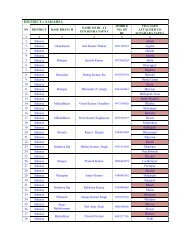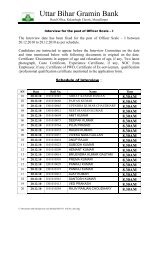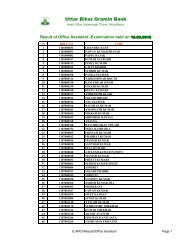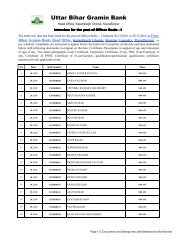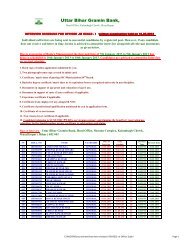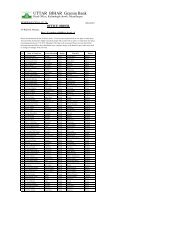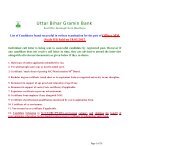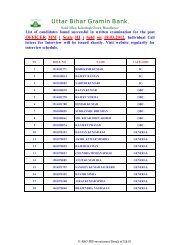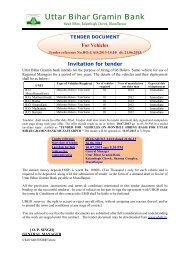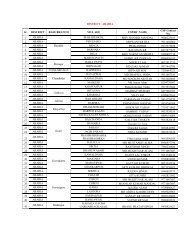UTTAR BHIAR (21032010) - Uttar Bihar Gramin Bank
UTTAR BHIAR (21032010) - Uttar Bihar Gramin Bank
UTTAR BHIAR (21032010) - Uttar Bihar Gramin Bank
You also want an ePaper? Increase the reach of your titles
YUMPU automatically turns print PDFs into web optimized ePapers that Google loves.
In classification, the Problem Figures are also the Answer Figures. Out of the five figures 1, 2, 3, 4 and 5, four are similar in<br />
a certain way and so form a group. One figure is not like the other four. The question is which one of the figures does not<br />
belong to this group.<br />
For example, look at the example at Q. No. 11. Of the five figures, four figures are such that in each of them, there are two<br />
similar figures, one within the other. These four figures form a group. Figure 1 is unlike this and so does not belong to this<br />
group. Therefore the answer is “1”.<br />
Problem–cum–Answer Figures<br />
Q.12.<br />
Study the five figures of Q.12. The first four figures form a group as they represent different types of containers while the fifth figure,<br />
a spoon, does not represent a container. Therefore the answer is “5”.<br />
Now attempt the following questions.<br />
Problem–cum–Answer Figures<br />
Q.13.<br />
Q.14.<br />
3. Series ($)<br />
Study the following problems based on series.<br />
Problem Figures<br />
Answer Figures<br />
Q.15.<br />
Note that the four figures given first at the left are called Problem Figures. The five figures given next are called Answer<br />
figures. They are indicated by numbers 1, 2, 3, 4 and 5.<br />
The four Problem Figures make a series. That means they change from left to right in a specific order. The question is “if the<br />
figures continue to change in the same order, what should the fifth figure be ? In the example above, as you go from left to right,<br />
you find that the arrow inside the circle keeps rotating at 90 0 in the clockwise direction. The question is, ‘if the arrow continues<br />
to rotate by the same amount in the clockwise direction, what will be its next, i.e. fifth position ? The answer is that it should point<br />
towards the top in the fifth figure. Answer Figure 2 shows this position of the arrow. Therefore, the answer is “2”.<br />
Problem Figures<br />
Answer Figures<br />
Q.16.<br />
Look at Q.16 carefully. You will see two different things happening here. From left to right, the number of black dots inside the<br />
hexagon is increasing by one everytime in the anti-clockwise direction. But note that the white dot is moving in the clockwise<br />
direction. In the fifth figure, the white dot should be at the upper left corner of the hexagon. Only Answer Figure 3 has both-one<br />
black dot getting added at the lower left corner and the white dot moving to the upper left corner. So, the answer is “3”.<br />
Note that there can be questions with five Problem Figures in the series type of questions. For example, study the<br />
Problem Figures in Q. No. 17.<br />
Problem Figures Answer Figures<br />
Q.17.<br />
Note that the number of arrows is increasing by 1 everytime and that they are gradually falling towards the left. In the sixth<br />
figure there should be six arrows and they should fall further and be lying flat, i.e. they should be horizontal. The answer,<br />
therefore, is “5”.<br />
Now solve the following questions.<br />
Problem Figures Answer Figures<br />
Q.18.<br />
15




